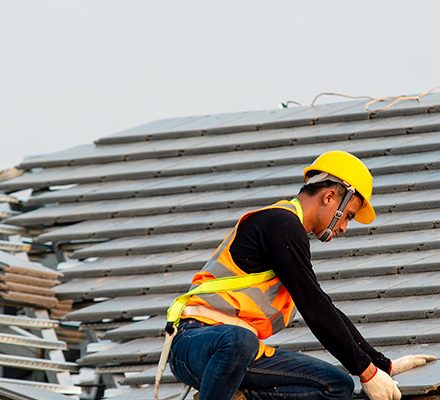The Dangers of Working at Height
Working at Height remains one of the biggest causes of fatalities and major injuries. Common causes include falls from ladders and through fragile surfaces.
Employers and employees must comply with the Work at Height Regulations 2005 whose main purpose is to attempt to prevent death and injury from a fall from height. The Health and Safety Executive have also provided guidance as to what employers and employees need to do to prevent falls from height.
Common Causes of Accidents when Working at Height
- Falls from Roofs
Roof work is high risk and such falls are one of the most common causes of workplace death and serious injury. Such falls can lead to fatalities, serious brain and spinal injuries. - Falls from Scaffolding
- Falls from Ladders

How high is the risk?
Where there are no precautions in place, working at height in any environment can increase a person’s risk of falling a distance, making them liable to personal injury. Examples include working on a ladder or flat roof, falling through a fragile surface or falling into an opening in a floor or a hole in the ground.
The regulations and the HSE guidance state that all efforts should be made to avoid working at height where it is reasonably practicable to do so but if it cannot be avoided, to prevent falls by working from a safe place with the right type of equipment.
The regulations apply to an employer or somebody who controls work at height, for example if you are a contractor or a factory owner.

How to Comply with these Regulations
Employers and those in control of work must ensure work is properly planned, supervised and carried out by competent people. This includes using the right type of equipment for working at height.
Factors for Employers to Consider when Planning Work at Height
- Take account of weather conditions that could compromise worker safety
- Check that the place where work at height is to be undertaken is safe
- Stop materials or objects falling from height
- Store materials and objects safely so they will not cause injury if they are disturbed or collapse
- Conduct a thorough risk assessment before commencing the work
- Use a work restraint (travel restriction) system that prevents the worker getting into a fall position, installing safety nets and soft-landing systems close to the level of the work
- Implement a fall arrest system

Employees’ Duties
Employees have general legal duties to take reasonable care of themselves and others who may be affected by their actions. Employees also have a duty of co-operating with their employer so that they can enable their health and safety duties and requirements to be complied with.
In particular, an employee must:
- Report any safety hazard they identify to their employer
- Use the equipment supplied in accordance with any training and instructions
- Consult with their employers regarding potential risks and hazards.
If you need advice regarding working at height or have been involved in an accident whilst working at height, please do not hesitate to contact our Bradley Wright on Bradley.Wright@edslaw.co.uk 0208 514 9000
